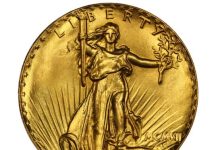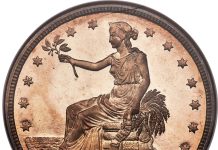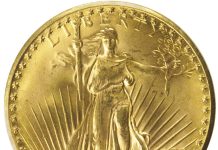 THE WEIGHT-ING GAME
THE WEIGHT-ING GAME
by Ed Reiter
It’s official: The Realm of Coins has a new heavyweight champion—with a seven-figure price tag to back its claim to the title.
A 2007 Canadian Maple Leaf containing 220.5 pounds of gold (that’s 100 kilograms to you metric-minded nerds) changed hands (or forklifts) for $4 million at an auction held in late June in Vienna, Austria. Put another way, it sold for 3.27 million euros.
That’s among the highest prices ever paid for a single coin. But most single coins are designed, of course, with people’s pockets—not flatbed trucks—in mind.
More to the point, the price appears to be an all-time record for a single bullion coin—for that’s how the auction bidders seem to have viewed this behemoth.
The coin is .9999 fine—essentially pure gold—and contains 2,646 troy ounces of gold. With the yellow metal trading for about $1,250 an ounce at the time of the sale, that translates into a bullion value of roughly $3.3 million.
Austria’s Dorotheum auction house, which conducted the sale, concluded–correctly, it appears–that bullion value, not rarity, was the primary motivation of the buyer, a Spanish precious-metal trading company called Oro Direct.
Dorotheum sold the coin as part of its liquidation of assets belonging to the previous owner, AvW Group, an Austrian investment firm that went bankrupt.
The coin is 21 inches (53 centimeters) in diameter and 1.2 inches thick, carries a face value of 1 million Canadian dollars ($960,000 U.S.) and bears the same design as the regular 1-ounce Maple Leaf, with the standard coinage portrait of Britain’s Queen Elizabeth II on the obverse and a (very large) likeness of the maple leaf, Canada’s national symbol, on the reverse.
Why make a coin weighing more than a tenth of a ton? As a pocket piece for Paul Bunyan … a teething ring for Godzilla?
It was produced by the Royal Canadian Mint (presumably with great difficulty) in what seems to have been a high-profile game of “Can You Top This?”
In 2004, the Austrian Mint celebrated the 15th anniversary of its Philharmonic gold bullion coin by producing 15 super-size examples of the coin, each containing 1,000 troy ounces (68.57 pounds) of pure gold and carrying a face value of 100,000 euros. This earned the giant Philharmonics a spot in Guinness World Records as the largest gold coins in the world.
Canadian officials—green with envy and flush with gold—set about rewriting the record book by coming up with an even more mammoth Maple Leaf. The RCM made just five examples of the 2007 coin, one of which reportedly found its way to Queen Elizabeth.
Obviously, being one of only five pieces known doesn’t do nearly as much for the value of a 220.5-pound gold coin as it does for a 5-gram base-metal five-cent piece. Five, of course, is also the number of known examples of the 1913 Liberty Head nickel. One of those sold for $4.15 million in 2005—making it more valuable than the huge Maple Leaf, as well as much more portable.
With all these gold gargantuans floating around, who can blame the U.S. Mint for seeking its “pound of flash” by offering 5-ounce silver versions of the (dare I say those trademarked words) “America the Beautiful” quarters depicting national parks and historic sites. These, after all, are every bit as impractical as the Austrian and Canadian manhole covers. And having intrinsic worth of about $100 each, they seem even more foolish with their statement of value inscribed as QUARTER DOLLAR.
What’s more, the Mint’s “hockey puck” silver coins should give certification services a chance to stretch their new “Plus” grading to the limit. With all the king-size slabs that could be required, in fact, this might be the best time to get into plastics since Mister McGuire gave that advice to Benjamin Braddock in “The Graduate.”
If this keeps up, British coins won’t be the only ones whose value is measured in pounds. And everyone’s pay will be based on scale.
Then again, the whole idea may end up going over like a lead balloon.
We’ll just have to weight and see.














I’m confused.
1 Troy Ounce is 31.1 grams.
Therefore 2646 Troy Ounces is just over 82 Kilos…
The coin is .9999 fineness…Where is the remaining 18 Kilos?
Great post! Been reading a lot about super valuable metals like this. Thanks for the info here!